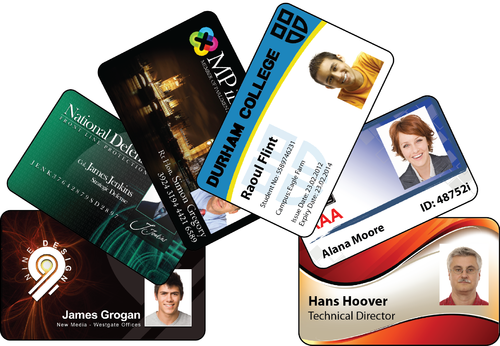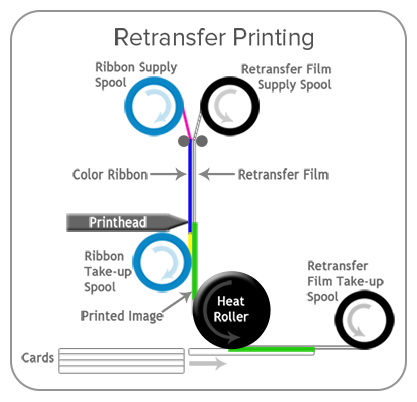ID Card printing can be quite complex – especially when compared with traditional inkjet printing.
There are a lot of different factors to consider when undertaking a card printing project.
It’s always good to know the fundamentals of the process before you tackle a print job.
This broad overview will cover many aspects of card printing and give you the knowledge you need to make the right decision first-time when getting cards printed.

Plastic Card Printing: The Basics
The fundamental technology is the same for all desktop card printers: A thermal print head is used in conjunction with a color film or “ribbon”, which fuses the color onto the card.
There are two principal methods for doing this. Direct print and retransfer print.
Direct Printing
Direct printing aka DTC or Direct To Card printing, is a card printing process by which the print head applies the ribbon color directly to the surface of the card.
The print head passes over each ribbon panel and vaporises the ink onto the card surface.
DTC printing is fast and cost-effective.
Printers use various ribbon types to achieve a desired finish.
A YMCK (Yellow, Magenta, Cyan, Black) ribbon is very common for printing full color, as these mixed together can create most conceivable shades of color.

Retransfer Printing
With retransfer printing, the fundamental process is very similar.
The key difference in retransfer printing is the transfer method of the ink to the card.
The image is first thermally printed onto a thin film.
This film is then transferred to the card surface with a gum roller.
This offers two significant benefits: a much higher print quality and the image will cover the entire surface of the card.
The retransfer method is also recommended for printing on chip cards.

Are there different printers for beginners and professionals?
Not as such, most modern desktop printers are very similar in terms of operation.
However, as you move up printer classes, they do tend to have more complex features such as holograms and encoding which come with an additional learning curve.
Generally, the more expensive the machine, the more complex it is to operate.
Do I need any technical knowledge before buying a printer?
For most printers, you typically do not need any prior experience or technical knowledge of card printers.
Most models have intuitive displays and clear operating instructions.
Card Encoding
Many printer models come equipped with encoding modules or can be upgraded post-purchase.
It’s good practice to enquire about encoding options before purchase as many models cannot be upgraded after purchase.
The following card encoding options are available:
- All Barcodes
- Magnetic Stripes
- Contactless Chips
- Contact Chips
Card Safety Features
For those with high security demands, many models offer advanced security options such as holographic printing or UV printing.
ID Card Printer Costs
A complete printing system can range from €825 up to €10000.
The cheapest card printing systems we found were at https://cardlogic.ie and https://smartcardprinters.ie/.
These systems include everything you need to start printing cards in-house.